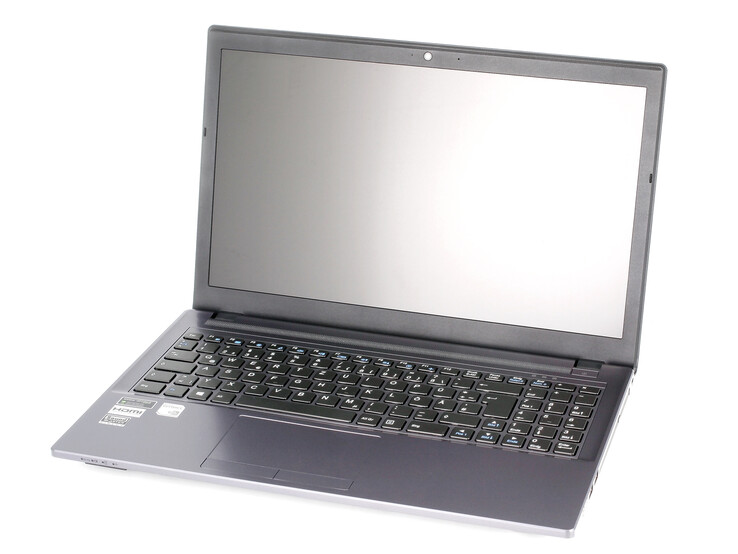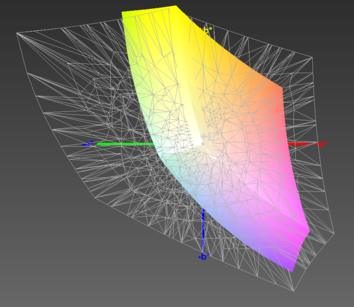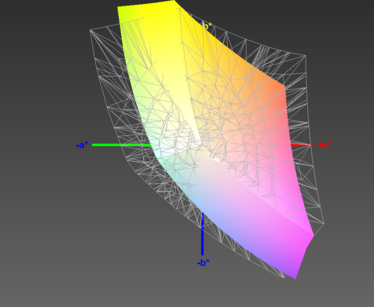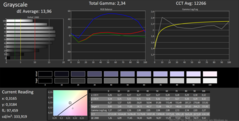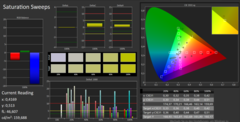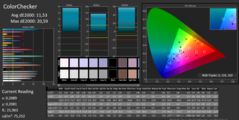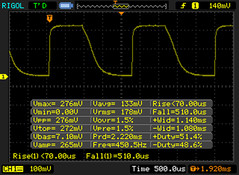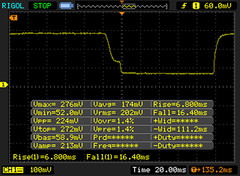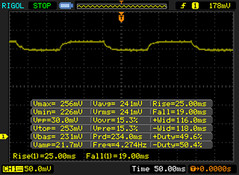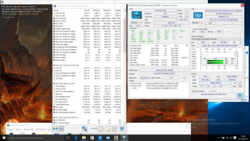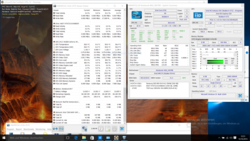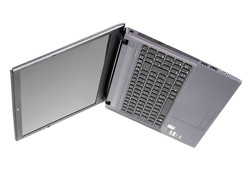Nexoc M512 III (Clevo W650RB) (i3,940M) Notebook Review

For the original German review, see here.
We reviewed the Nexoc M512 for the first time in mid-2013. Since then, the chassis has remained essentially unchanged and only the eSATA port was replaced by a USB 3.0 port. From a technical aspect, Nexoc has integrated many different hardware components over time, ranging from Ivy Bridge (i7-3540M) to Haswell CPUs and now to the brand-new Skylake Core i3 6100H.
The built-to-order (BTO) manufacturer uses Clevo's Barebone W650RB as the base and offers options like the GeForce 940M, GTX 950M and standard voltage Core i3, i5 and i7 CPUs part of the Skylake-generation. How the smallest 35-watt Skylake processor compares to Haswell and the bigger brother i7 6700HQ is the subject of our review.
Case & Connectivity
A simple design, inexpensive though not cheap, but not that sturdy: that's how we could summarize the chassis. The base unit is easy to twist and protests with creaking sounds in the area of the optical drive. The gaps are small and the surfaces are either matte or feature a brushed metal look. We were able to loosen the display bezel by hand - that definitely shouldn't happen. The M512 III is easy to maintain and upgrade, which is typical for BTO barebones. Every omponent a user chooses during the build process can be swapped out at a later time. The WLAN module (M.2), SSD (M.2), hard drive (SATA) and RAM (2 slots) are all pluggable. Exceptions are the processor and the GPU, since both are soldered onto the motherboard. The battery is of course swappable.
Nexoc uses a Intel Wireless AC 7265 WLAN module which worked as expected during the review period. We checked the performance of the integrated card reader with our Toshiba Exceria Pro SDXC 64 GB UHS-II reference SD card and recorded speeds of up to 87 MB/s when copying large data blocks (AS-SSD Read) and 68 MB/s for average JPEGs (about 5 MB each). These are very good transfer rates.
Input Devices
The keyboard is very stiff and typing on it is not very satisfying. There's no flex whatsover, but the stroke is simply too hard with short key travel. The actuation itself is well defined but starts at the very beginning of the key stroke, which leads to an overall very wooden typing experience. We wouldn't want to use this keyboard for extented periods of time, particularly since the keys are flat without concave surface guiding the fingertips.
The touchpad is better, even though the two buttons should have more travel in our opinion. At least they remain quiet during clicks and are easy to depress. The pad is large and the slighty rough surface lets fingers glide easily.
Display
The Innolux CMN15BA is a mainstream TN panel which in theory should feature quick response times, although it suffers from very weak viewing angle stability - particularely from the side. The non-glare Full-HD display features a resolution of 1920 x 1080 pixels and is - for a multimedia notebook - quite bright at 310 nits. The table below shows that the competitors sometimes don't even get close and remain clearly under 300 nits at times. Color accuracy is not that great either, which was to be expected given the high contrast ratio of 1233:1. The avarage DeltaE is 12 to 14; deally the values should remain under 3. The result is not only a distinctly bluish hue, but also color deviations that are visible to the naked eye (see the CALMAN screenshots below). The color profile linked in the box above should help somewhat - at least to correct the bluish hue.
The panel uses PWM (pulse width modulation) for all brightness levels except maimum.
| |||||||||||||||||||||||||
Brightness Distribution: 83 %
Center on Battery: 333 cd/m²
Contrast: 1233:1 (Black: 0.27 cd/m²)
ΔE Color 11.53 | 0.5-29.43 Ø5
ΔE Greyscale 13.96 | 0.57-98 Ø5.3
71% sRGB (Argyll 1.6.3 3D)
46% AdobeRGB 1998 (Argyll 1.6.3 3D)
50.3% AdobeRGB 1998 (Argyll 2.2.0 3D)
70.9% sRGB (Argyll 2.2.0 3D)
48.96% Display P3 (Argyll 2.2.0 3D)
Gamma: 2.34
| Nexoc M512 III W650RB (i3,940M) GeForce 940M, 6100H, Samsung SSD 850 EVO 250GB | SCHENKER XMG A706 GeForce GTX 960M, 6700HQ, Samsung SSD 850 EVO M.2 250 GB | Acer Aspire E5-473G-59QT GeForce 940M, 5200U, Seagate ST500LM000 Solid State Hybrid Drive | Lenovo ThinkPad Edge E550-20DGS00300 HD Graphics 5500, 5005U, Hitachi Travelstar Z7K500 HTS725050A7E630 | Medion Akoya E6417-MD99248 Iris Graphics 6100, 5157U, Seagate ST1000LM014 Solid State Hybrid Drive | Wortmann Terra Mobile 1548 GeForce GT 740M, 4000M, WDC Scorpio Blue WD10JPVX-22JC3T0 | |
|---|---|---|---|---|---|---|
| Display | 25% | -22% | -16% | -18% | -1% | |
| Display P3 Coverage | 48.96 | 66.4 36% | 37.82 -23% | 40.69 -17% | 39.76 -19% | 48.42 -1% |
| sRGB Coverage | 70.9 | 83.8 18% | 56.9 -20% | 61.1 -14% | 59.6 -16% | 71 0% |
| AdobeRGB 1998 Coverage | 50.3 | 61.3 22% | 39.07 -22% | 42.06 -16% | 41.09 -18% | 50 -1% |
| Screen | 17% | -26% | -33% | -3% | -58% | |
| Brightness middle | 333 | 344 3% | 238 -29% | 228 -32% | 227 -32% | 372 12% |
| Brightness | 311 | 322 4% | 228 -27% | 210 -32% | 237 -24% | 354 14% |
| Brightness Distribution | 83 | 88 6% | 90 8% | 89 7% | 85 2% | 89 7% |
| Black Level * | 0.27 | 0.3 -11% | 0.54 -100% | 0.688 -155% | 0.29 -7% | 1.24 -359% |
| Contrast | 1233 | 1147 -7% | 441 -64% | 331 -73% | 783 -36% | 300 -76% |
| Colorchecker dE 2000 * | 11.53 | 4.8 58% | 10.64 8% | 10.04 13% | 6.06 47% | 12.09 -5% |
| Greyscale dE 2000 * | 13.96 | 4.91 65% | 11.74 16% | 10.65 24% | 5.65 60% | 14.07 -1% |
| Gamma | 2.34 94% | 2.37 93% | 2.42 91% | 2.53 87% | 2.51 88% | 2.28 96% |
| Color Space (Percent of AdobeRGB 1998) | 46 | 55 20% | 36 -22% | 38.8 -16% | 38 -17% | |
| Color Space (Percent of sRGB) | 71 | 84 18% | 57 -20% | 59 -17% | ||
| CCT | 6796 96% | 13043 50% | 12807 51% | 7122 91% | 13480 48% | |
| Total Average (Program / Settings) | 21% /
19% | -24% /
-25% | -25% /
-28% | -11% /
-6% | -30% /
-41% |
* ... smaller is better
A positive fact is that the maximum brightness remains available even with the notebook running on battery power. Working in daylight is possible and not plagued by a lot reflections. Many competitors lower the luminance on battery to conserve power.
Performance
The Intel Core i3 6100H looks like it might be a true entry-level processor and - at least according to the nomenclature - it is. The system isn't anemic by any means, however, as we can see in the following comparison. With both an integrated HD Graphics 5300 and a dedicated Nvidia Geforce 940M (Optimus technology), the 15-inch notebook was designed for office work as well as entertainment and productivity. Nexoc increases the perceived speed with a Samsung SSD 850 EVO (250 GB) and a 1 TB Hitachi HTS7210 hard drive. The SSD houses the operating system, so fast response times are a given for this i3 system.
Processor
The main difference between the Core i3 and i5/i7 CPUs is the lack of a Turbo. Our obligatory check of the frequencies showed the cores to run at the nominal clock speed of 2.7 GHz even during the stress test. The SoC didn't get too warm either at 62 degrees C according to HWinfo. For the technical details, please check our dedicated page for the Intel Core i3-6100H.
The Cinebench measurements in the chart below show clearly that there are significant performance differences between the i3 and the 6700HQ, which Nexox also offers as an option for this notebook. The i7 is about 57 % and 112 % faster during the single and multi-core portions of the Cinebench R15 benchmark test. The Core i5 6440HQ was not yet available at the time of testing. The Broadwell i5 5200U (15 watt TDP) manages to keep up quite well, especially during the single-core test (thanks to its Turbo). The 15 watt Core i3 5005U, on the other hand, has not chance (-26 % and -30 %; Multi/Single). The older 35 watt Haswell Core i3 4000M is roughly 20 % slower.
| Cinebench R11.5 | |
| CPU Single 64Bit (sort by value) | |
| Nexoc M512 III W650RB (i3,940M) | |
| SCHENKER XMG A706 | |
| Acer Aspire E5-473G-59QT | |
| Lenovo ThinkPad Edge E550-20DGS00300 | |
| Medion Akoya E6417-MD99248 | |
| Wortmann Terra Mobile 1548 | |
| CPU Multi 64Bit (sort by value) | |
| Nexoc M512 III W650RB (i3,940M) | |
| SCHENKER XMG A706 | |
| Acer Aspire E5-473G-59QT | |
| Lenovo ThinkPad Edge E550-20DGS00300 | |
| Medion Akoya E6417-MD99248 | |
| Wortmann Terra Mobile 1548 | |
| Cinebench R15 | |
| CPU Single 64Bit (sort by value) | |
| Nexoc M512 III W650RB (i3,940M) | |
| SCHENKER XMG A706 | |
| Acer Aspire E5-473G-59QT | |
| Lenovo ThinkPad Edge E550-20DGS00300 | |
| Medion Akoya E6417-MD99248 | |
| CPU Multi 64Bit (sort by value) | |
| Nexoc M512 III W650RB (i3,940M) | |
| SCHENKER XMG A706 | |
| Acer Aspire E5-473G-59QT | |
| Lenovo ThinkPad Edge E550-20DGS00300 | |
| Medion Akoya E6417-MD99248 | |
| Cinebench R10 | |
| Rendering Single 32Bit (sort by value) | |
| Nexoc M512 III W650RB (i3,940M) | |
| SCHENKER XMG A706 | |
| Acer Aspire E5-473G-59QT | |
| Lenovo ThinkPad Edge E550-20DGS00300 | |
| Rendering Multiple CPUs 32Bit (sort by value) | |
| Nexoc M512 III W650RB (i3,940M) | |
| SCHENKER XMG A706 | |
| Acer Aspire E5-473G-59QT | |
| Lenovo ThinkPad Edge E550-20DGS00300 | |
System Performance
The overal system performance, which we evaluate with the PCMark 7 and PCMark 8 benchmark tests, is on par with other well-equipped consumer-level notebooks like the Acer Aspire E5-473G-59QT with 15 watt Core i5 processor. The XMG A706 with Core i7 and GTX 960M, on the other hand, is capable of 20 to 30 % better performance.
| PCMark 8 Home Score Accelerated v2 | 3039 points | |
| PCMark 8 Work Score Accelerated v2 | 4178 points | |
Help | ||
Storage Devices
The Samsung SSD 850 EVO offers a capacity of 250 GB and allows for fast load as well as copy times. The SSD in the Schenker XMG A706 clearly trails the review notebook, as do the competitors with regular hard drives.
| Nexoc M512 III W650RB (i3,940M) GeForce 940M, 6100H, Samsung SSD 850 EVO 250GB | SCHENKER XMG A706 GeForce GTX 960M, 6700HQ, Samsung SSD 850 EVO M.2 250 GB | Acer Aspire E5-473G-59QT GeForce 940M, 5200U, Seagate ST500LM000 Solid State Hybrid Drive | Lenovo ThinkPad Edge E550-20DGS00300 HD Graphics 5500, 5005U, Hitachi Travelstar Z7K500 HTS725050A7E630 | Medion Akoya E6417-MD99248 Iris Graphics 6100, 5157U, Seagate ST1000LM014 Solid State Hybrid Drive | Wortmann Terra Mobile 1548 GeForce GT 740M, 4000M, WDC Scorpio Blue WD10JPVX-22JC3T0 | |
|---|---|---|---|---|---|---|
| CrystalDiskMark 3.0 | -10% | -89% | -88% | -87% | -89% | |
| Read 4k | 45.18 | 38.91 -14% | 0.369 -99% | 0.659 -99% | 0.579 -99% | 0.538 -99% |
| Write 4k | 101.5 | 90.4 -11% | 0.762 -99% | 1.452 -99% | 1.649 -98% | 1.568 -98% |
| Read Seq | 527 | 506 -4% | 113.7 -78% | 124.3 -76% | 119 -77% | 110.2 -79% |
| Write Seq | 501 | 448.9 -10% | 110.1 -78% | 122.5 -76% | 123.7 -75% | 107.5 -79% |
GPU Performance
The GT 940M is a well-known entry-level GPU suitable for playing current games at least at medium settings. The i3 isn't a bottleneck at all, as other notebooks with the 940M (Aspire E5-473G) performed almost identical during the synthetic benchmark test. The GTX 960M is in a league of its own though and the XMG A706 is faster by up to 100 %.
| 3DMark 11 | |
| 1280x720 Performance (sort by value) | |
| Nexoc M512 III W650RB (i3,940M) | |
| SCHENKER XMG A706 | |
| Acer Aspire E5-473G-59QT | |
| Lenovo ThinkPad Edge E550-20DGS00300 | |
| Medion Akoya E6417-MD99248 | |
| Wortmann Terra Mobile 1548 | |
| 1280x720 Performance GPU (sort by value) | |
| Nexoc M512 III W650RB (i3,940M) | |
| SCHENKER XMG A706 | |
| Lenovo ThinkPad Edge E550-20DGS00300 | |
| Wortmann Terra Mobile 1548 | |
| 1280x720 Performance Physics (sort by value) | |
| Nexoc M512 III W650RB (i3,940M) | |
| SCHENKER XMG A706 | |
| Lenovo ThinkPad Edge E550-20DGS00300 | |
| Wortmann Terra Mobile 1548 | |
| 1280x720 Performance Combined (sort by value) | |
| Nexoc M512 III W650RB (i3,940M) | |
| SCHENKER XMG A706 | |
| Lenovo ThinkPad Edge E550-20DGS00300 | |
| Wortmann Terra Mobile 1548 | |
| 3DMark | |
| 1280x720 Cloud Gate Standard Score (sort by value) | |
| Nexoc M512 III W650RB (i3,940M) | |
| SCHENKER XMG A706 | |
| Acer Aspire E5-473G-59QT | |
| Lenovo ThinkPad Edge E550-20DGS00300 | |
| Medion Akoya E6417-MD99248 | |
| Wortmann Terra Mobile 1548 | |
| 1280x720 Cloud Gate Standard Graphics (sort by value) | |
| Nexoc M512 III W650RB (i3,940M) | |
| SCHENKER XMG A706 | |
| Lenovo ThinkPad Edge E550-20DGS00300 | |
| Wortmann Terra Mobile 1548 | |
| 1280x720 Cloud Gate Standard Physics (sort by value) | |
| Nexoc M512 III W650RB (i3,940M) | |
| SCHENKER XMG A706 | |
| Lenovo ThinkPad Edge E550-20DGS00300 | |
| Wortmann Terra Mobile 1548 | |
| 3DMark 06 Standard Score | 11966 points | |
| 3DMark 11 Performance | 2541 points | |
| 3DMark Ice Storm Standard Score | 47282 points | |
| 3DMark Cloud Gate Standard Score | 6427 points | |
| 3DMark Fire Strike Score | 1422 points | |
Help | ||
Gaming Performance
A check with actual games - we tried Battlefield Hardline - promises relaxed entry-level gaming. The M512 III was able to render pages as quickly as the fastest 940M systems equipped with 15 watt CPUs.
| Battlefield Hardline | |
| 1366x768 Medium Graphics Quality (DX11) (sort by value) | |
| Nexoc M512 III W650RB (i3,940M) | |
| HP Pavilion 17-g013ng | |
| Asus F751LB-T4030H | |
| 1920x1080 High Graphics Quality (DX11) (sort by value) | |
| Nexoc M512 III W650RB (i3,940M) | |
| HP Pavilion 17-g013ng | |
| Asus F751LB-T4030H | |
| low | med. | high | ultra | |
| Battlefield Hardline (2015) | 54.2 | 18.2 | 10.8 |
Emissions & Energy
System Noise
The noise level could theoretically approach zero, since the fan system is often not acitve at all during idle and even under load scenarios. Unfortunately, the 7200 RPM hard drive makes that impossible, as it registered at 34 dB on its own. Under full load, the fan spools up and the noise increases to up to 44 dB while playing games and 49 dB during the stress test. If required, the M512 III will get quite noisy to keep the chassis cool, although that's pretty unrealistic under normal circumstances.
Noise Level
| Idle |
| 34.4 / 34.4 / 34.4 dB(A) |
| DVD |
| 37.4 / dB(A) |
| Load |
| 44 / 49.4 dB(A) |
 | ||
30 dB silent 40 dB(A) audible 50 dB(A) loud |
||
min: | ||
Temperature
The chassis doesn't get overly warm thanks to the capacity of the cooling system. Even when equipped with Core i7 CPU and GTX 950M GPU, the notebook remains cool at all times.
(+) The maximum temperature on the upper side is 36.4 °C / 98 F, compared to the average of 36.9 °C / 98 F, ranging from 21.1 to 71 °C for the class Multimedia.
(+) The bottom heats up to a maximum of 36.7 °C / 98 F, compared to the average of 39.1 °C / 102 F
(+) In idle usage, the average temperature for the upper side is 28.9 °C / 84 F, compared to the device average of 31.2 °C / 88 F.
(±) The palmrests and touchpad can get very hot to the touch with a maximum of 36.4 °C / 97.5 F.
(-) The average temperature of the palmrest area of similar devices was 28.8 °C / 83.8 F (-7.6 °C / -13.7 F).
Speakers
The loudspeakers sound tinny and music and games are hard to endure as a result. The two speakers, which are located at the front of the notebook, don't get very loud compared to other notebooks and struggle to fill even an average room.
Power Consumption
Does a Skylake CPU consume less power? The 14 nm construction promises an increase in efficiency and consequently a lower power draw, but the M512 seems to be the exception. During idle, our notebook consumed between 13 and 19 watts, even when we removed the battery to prevent charging during the test run. The results are bewildering to say the least, as even the GTX powerhouses only need between 5 and 16 watts (XMG A706). We don't think that the i3 processor is the culprit - after all, even the first-generation M512 consumed lots of power in standby mode.
During load, the difference isn't quite as noticeable, although 15 watt systems like the Aspire E5-473G consume less power - especially the ones without dedicated graphics (ThinkPad Edge E550, for example).
| Nexoc M512 III W650RB (i3,940M) GeForce 940M, 6100H, Samsung SSD 850 EVO 250GB | SCHENKER XMG A706 GeForce GTX 960M, 6700HQ, Samsung SSD 850 EVO M.2 250 GB | Acer Aspire E5-473G-59QT GeForce 940M, 5200U, Seagate ST500LM000 Solid State Hybrid Drive | Lenovo ThinkPad Edge E550-20DGS00300 HD Graphics 5500, 5005U, Hitachi Travelstar Z7K500 HTS725050A7E630 | Medion Akoya E6417-MD99248 Iris Graphics 6100, 5157U, Seagate ST1000LM014 Solid State Hybrid Drive | Wortmann Terra Mobile 1548 GeForce GT 740M, 4000M, WDC Scorpio Blue WD10JPVX-22JC3T0 | |
|---|---|---|---|---|---|---|
| Power Consumption | -1% | 45% | 61% | 47% | 21% | |
| Idle Minimum * | 12.7 | 5.4 57% | 4.6 64% | 3.3 74% | 5.3 58% | 10.8 15% |
| Idle Average * | 17.8 | 11 38% | 6.3 65% | 6.5 63% | 6.6 63% | 15.6 12% |
| Idle Maximum * | 19.3 | 16.5 15% | 8.8 54% | 7 64% | 8.4 56% | 15.8 18% |
| Load Average * | 53.9 | 77.8 -44% | 43.3 20% | 27.3 49% | 44.6 17% | 38.2 29% |
| Load Maximum * | 80.5 | 137.7 -71% | 61.5 24% | 35.6 56% | 46.6 42% | 56.8 29% |
* ... smaller is better
| Off / Standby | |
| Idle | |
| Load |
|
Battery Life
The run times during the WLAN test show the realistic battery life while web surfing with reduced brightness (level 6 at 135 cd/m² in the middle). 249 minutes - a bit more than 4 hours - isn't that impressive when compared to the competitors.
| Battery Runtime | |
| WiFi v1.3 (sort by value) | |
| Nexoc M512 III W650RB (i3,940M) | |
| SCHENKER XMG A706 | |
| Acer Aspire E5-473G-59QT | |
| Lenovo ThinkPad Edge E550-20DGS00300 | |
| Medion Akoya E6417-MD99248 | |
| WiFi (sort by value) | |
| Lenovo ThinkPad Edge E550-20DGS00300 | |
| Wortmann Terra Mobile 1548 | |
Pros
Cons
Verdict
The 35 watt Skylake Core i3 is significantly slower than the same-generation Core i7 6700HQ CPU. Hardcore testers of course aren't really surprised, although the overall performance slightly ahead of the (extremely popular) i5 5200U processor (-15 %) is still astonishing. The i3 6100H - especially when combined with a fast SSD - guarantees good performance well ahead of a common "typewriter". Unfortunately the Clevo Barebone M512 still manages to push idle power consumption into almost unknown terretories. The Nexoc M512 III (W650RB) is a 15.6-inch notebook that won't take the breath away or overly excite anybody - the chassis dating back to 2013 couln't possibly look more boring. Drawbacks are the lack of stability, the issues with the display frame and the stiff keyboard. The display isn't a revelation either: despite the fact that it is reasonably bright and non-glare to boot, both the viewing angle stability and the color reproduction leave to be desired. The contrast is extremely high, but the response time doesn't exceed those of current IPS displays with much better viewing angles.
The M512 III offers quite a bit of technology for a price of 799 Euro (~$880) and offers performance ahead of a low-voltage core i5 processor. It is equipped with a 940M GPU, a 250 GB SSD, ac-WLAN, a 1 TB HDD and a matte and bright Full-HD panel. The 15-inch system should theoretically earn a recommendation for the price-performance ratio, especially since it's fully configurable. Unfortunately, the chassis, input devices, and the TN TFT don't quite measure up.
Nexoc M512 III W650RB (i3,940M)
-
10/13/2015 v4(old)
Sebastian Jentsch


 Deutsch
Deutsch English
English Español
Español Français
Français Italiano
Italiano Nederlands
Nederlands Polski
Polski Português
Português Русский
Русский Türkçe
Türkçe Svenska
Svenska Chinese
Chinese Magyar
Magyar